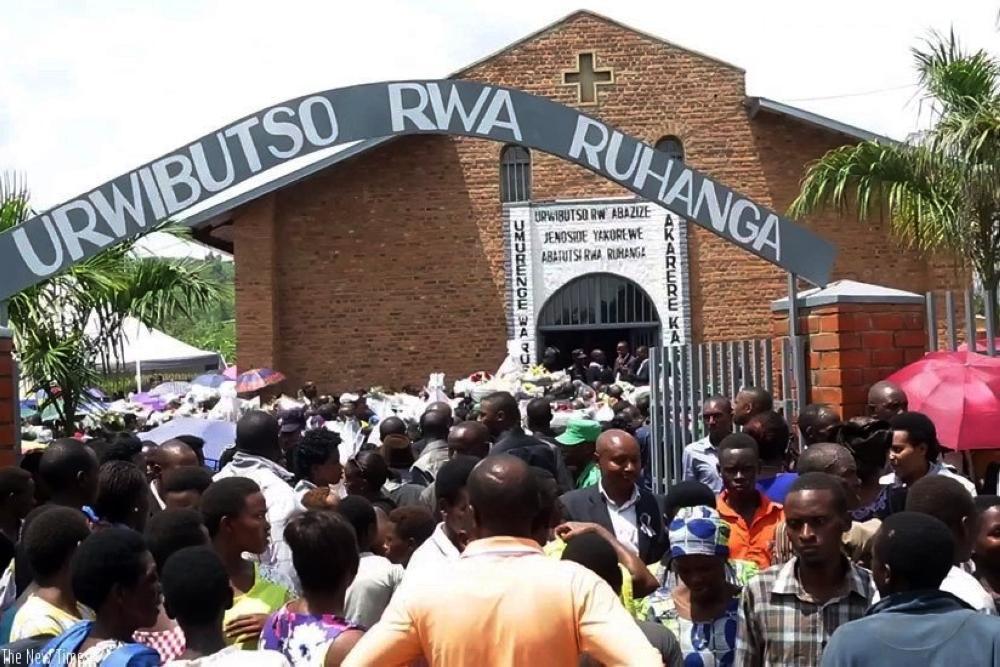Africa-Press – Rwanda. The killings of the Tutsi continued on April 13, 1994, with many being perpetrated in churches and other religious facilities across the country.
In Kigali, there were mass killings of the Tutsi at Collège Saint André, Charles Lwanga church and at St Joseph convent in Nyamirambo.
Many Tutsi had taken refuge at the religious facilities, having fled from places like Butamwa, Nyamirambo (Kivugiza, Mumena), Nyakabanda, Rwezamenyo, Kabusunzu, Nyarugenge (Biryogo).
According to records, the highest number of the Tutsi was killed at St Joseph convent, followed by those at College St Adre, and those murdered at Charles Lwanga church.
At St Joseph Convent, some Josephite brothers in charge of the facility refused to allow the killers to lay their hands on the Tutsi. The killers murdered the Josephite brothers too.
Some survivors say that there were more than 2,000 Tutsi refugees at the facility, because after the carnage, corpses were very many, piling on top of each other.
Massacres at Gishaka Church in Bumbogo, Kigali
In Bumbogo, a Kigali suburb, on the morning of April 7, 1994, Interahamwe began to blow their whistles, a signal for hunting down the Tutsi.
Many Tutsi gathered at Nkuzuzu hill where they put up resistance using stones, spears and arrows against the Interahamwe who had attacked them. They resisted for a couple of days, from April 7 to April 12. When Interahamwe realised that they were at risk of failing to accomplish their mission, they called for reinforcement from government soldiers.
With reinforcements, on April 13, 1994, they attacked the Tutsi using guns, and murdered many. The few survivors went to take refuge in the Gishaka Parish, where Father Michel, an expatriate religious leader, welcomed them.
He put them together with their Tutsi counterparts who had sought refuge at the facility earlier.
The priest tried to provide for their needs and also prayed for their souls since the night of April 13, 1994. The next day, April 14, 1994, Interahamwe and police officers from Gikomero Commune, including Michel Nyarwaya, Brigadier of the municipal police, Rubanguka Mathias, attacked and murdered many of them.
Massacres at Musha Catholic Church, Kigali
Between April 12-13, 1994, over 8,000 Tutsi were killed at the Catholic parish of Musha in Kigali, in an attack perpetrated by officials including Paul Bisengimana, the bourgoumestre of Gikoro Commune.
The Interahamwe first attacked women and girls, molested and raped them, before starting to kill those who were taking refuge at the parish.
Paul Bisengimana pleaded guilty to genocide before the International Criminal Tribunal for Rwanda. He was sentenced to 15 years in prison. He completed his sentence.
Massacres at Rukara Catholic church, Kayonza
Many Tutsi who had taken refuge at Rukara church, near Gahini were also attacked and murdered on April 13, 1994.
Twelve of them were killed while fighting against the Interahamwe who wanted to take over their cattle herd. The Interahamwe then seized all of the refugees’ property before massacring them.
The massacres were coordinated by Jean Mpambara, the bourgmestre of Rukara Commune, working together with Interahamwe from Murambi.
Mpambara was acquitted by the International Criminal Tribunal for Rwanda, but the survivors affirm that he was at the head of the massacres.
Massacres in Kanyinya, Nyarugenge Commune
In Kanyinya Sector, Nyarugenge Commune, Kigali, Joseph Nzabamwita, a local leader (Councilor) asked the Tutsi to call their counterparts to gather together so that he would get them security. He was lying.
On April 13, 1994, Nzabamwita told them that he was going to look for gendarmes (policemen) who would protect them. They were that they would be brought to a hilly place called Kana where Interahamwe could not located them.
Upon arrival there, they were told to wait since supplies and provisions were coming, but instead, in the evening it was the Interahamwe who arrived. They killed them with traditional weapons overnight.
Massacres at Ruharambuga, Nyamasheke
On the same day, Interahamwe of Rukoma led by Wellars Gasarasi surrounded more than 60 Tutsi gathered them at the home of a resident called Asterie Nyirandimubenshi. They massacred them.
After killing them, Gasarasi brought together Interahamwe, thanked them for what they had accomplished, and authorised them to seize the property of the Tutsi.
More massacres took place in various places across the country including Cyangugu (Rusizi), Kibuye (Karongi), Kayonza, and Gikongoro (current Nyamagabe).
For More News And Analysis About Rwanda Follow Africa-Press






